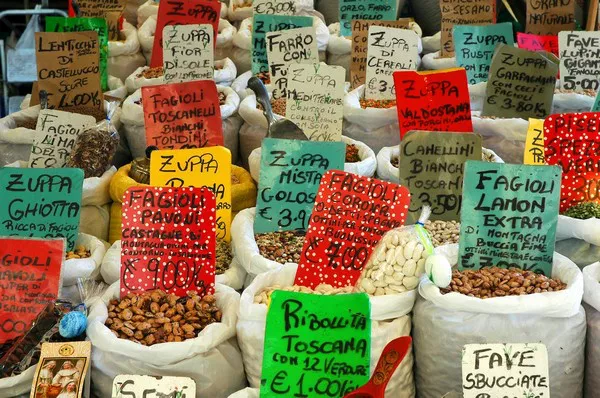Beans have long been celebrated for their nutritional value, versatility, and role in promoting overall health. As a staple in cuisines around the world, beans offer a rich source of plant-based protein, fiber, vitamins, and minerals. They are a favorite among vegetarians and vegans for their ability to provide essential nutrients typically found in animal products. In this comprehensive article, we will explore the health benefits of beans and highlight seven of the healthiest beans to incorporate into your diet, as recommended by dietitians and nutrition experts.
The Nutritional Facts of Beans
Beans, a type of legume, belong to the plant family Fabaceae and are characterized by their seeds enclosed in pods. While there are thousands of bean varieties, they share common nutritional attributes that make them a valuable addition to a balanced diet:
1. High-Quality Protein
Beans are an excellent source of plant-based protein, making them an essential component of vegetarian and vegan diets. Protein is vital for tissue repair, muscle maintenance, and overall growth and development.
2. Dietary Fiber
Beans are loaded with dietary fiber, which aids in digestion, promotes regular bowel movements, and helps manage blood sugar levels. Fiber also contributes to a feeling of fullness, making beans an ideal food for weight management.
3. Vitamins and Minerals
Beans are rich in several essential vitamins and minerals, including folate (vitamin B9), potassium, magnesium, and iron. These nutrients play various roles in maintaining overall health, from supporting the immune system to regulating blood pressure.
4. Antioxidants
Many beans, especially dark-colored varieties like black beans and kidney beans, contain antioxidants such as flavonoids and polyphenols. Antioxidants help protect cells from oxidative stress and reduce the risk of chronic diseases.
5. Low in Fat
Beans are naturally low in fat, making them a heart-healthy choice. They provide essential nutrients without the saturated fats found in many animal-based protein sources.
7 Healthiest Beans to Include in Your Diet
Now that we’ve highlighted the nutritional benefits of beans, let’s delve into seven of the healthiest beans to eat, as recommended by dietitians and nutrition experts:
1. Chickpeas (Garbanzo Beans)
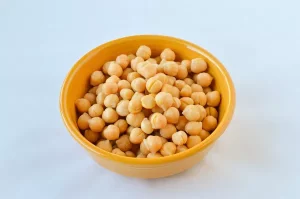
Chickpeas are renowned for their versatility and nutritional profile. They are an excellent source of plant-based protein, fiber, and several essential vitamins and minerals. Chickpeas are a staple in Mediterranean and Middle Eastern cuisines and are commonly used in dishes like hummus, falafel, and salads.
Health Benefits:
Rich in folate, which is crucial for fetal development and cell division.
High levels of manganese, supporting bone health and metabolism.
Aids in weight management due to their high fiber content and ability to promote fullness.
2. Black Beans
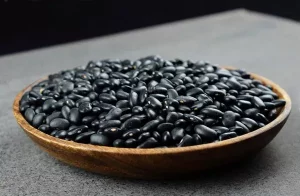
Black beans are a popular choice among nutrition experts for their impressive nutrient content. They are a fantastic source of plant-based protein and fiber and offer numerous health benefits. Black beans are commonly used in Latin American and Caribbean dishes, including black bean soup and rice and beans.
Health Benefits:
Loaded with antioxidants that combat oxidative stress and reduce the risk of chronic diseases.
Abundant in iron, which is essential for oxygen transport in the body.
Helps regulate blood sugar levels due to their low glycemic index.
3. Lentils
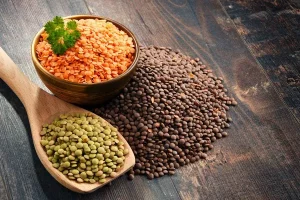
Lentils are a nutrient powerhouse and are particularly favored for their protein content and quick cooking time. They come in various varieties, including brown, green, and red lentils, each with its unique culinary uses. Lentils are a staple in Indian, Mediterranean, and vegetarian cuisines.
Health Benefits:
Rich in folate and magnesium, which support heart health and overall well-being.
An excellent source of plant-based iron, important for preventing anemia.
High in soluble fiber, promoting digestive health and lowering cholesterol levels.
4. Kidney Beans
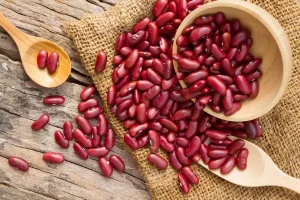
Kidney beans are known for their robust flavor and are often used in chili, soups, and salads. They are a great source of plant-based protein and fiber, making them a valuable addition to a variety of dishes.
Health Benefits:
Contain thiamine (vitamin B1), which plays a vital role in energy metabolism.
High in potassium, which helps regulate blood pressure and fluid balance.
Provide a good amount of plant-based iron, important for oxygen transport in the body.
5. Pinto Beans
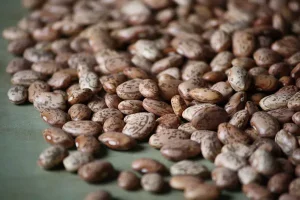
Pinto beans, named for their mottled appearance, are a staple in Mexican and Southwestern cuisine. They are packed with nutrients and offer a mild, earthy flavor that complements a wide range of dishes.
Health Benefits:
Rich in folate, promoting cell division and reducing the risk of birth defects.
A good source of fiber, aiding in digestion and maintaining a healthy weight.
Provide essential minerals like magnesium and potassium for overall health.
6.Navy Beans
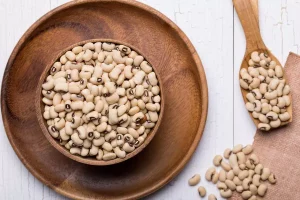
Navy beans, also known as haricot beans, are small, creamy-white beans often used in baked bean recipes. They are highly nutritious and are appreciated for their versatility in both sweet and savory dishes.
Health Benefits:
Exceptionally high in fiber, which supports digestive health and heart health.
Rich in B vitamins, including B1 (thiamine), B3 (niacin), and B6 (pyridoxine).
Low in fat and calories, making them an excellent choice for weight management.
7. Adzuki Beans
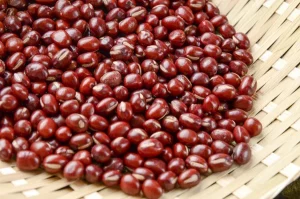
Adzuki beans, commonly used in Asian cuisines, are small, reddish-brown beans with a slightly sweet flavor. They are a great source of plant-based protein and essential nutrients.
Health Benefits:
Abundant in folate, supporting brain function and preventing neural tube defects.
High in potassium, helping regulate blood pressure and fluid balance.
Contain antioxidants like anthocyanins, which combat free radicals and reduce oxidative stress.
How to Incorporate More Beans into Your Diet
Now that you’re familiar with the healthiest beans to eat, you may wonder how to include them in your meals. Here are some creative and delicious ways to incorporate beans into your diet:
1. Bean Salad: Create a colorful and nutritious bean salad by combining various beans with chopped vegetables, fresh herbs, and a flavorful dressing.
2. Hummus: Whip up homemade hummus using chickpeas, tahini, garlic, lemon juice, and olive oil. Enjoy it as a dip or spread.
3. Bean Soups: Make hearty bean soups using your favorite bean variety, vegetables, and aromatic herbs and spices.
4. Bean Burritos: Stuff whole-grain tortillas with beans, rice, salsa, and avocado for a satisfying and nutritious meal.
5. Bean Burgers: Prepare homemade bean burgers using mashed beans, breadcrumbs, and seasonings. Grill or pan-fry for a meatless alternative.
6. Bean Chili: Create a flavorful bean chili using kidney beans, black beans, or pinto beans, along with tomatoes, chili powder, and your choice of vegetables.
7. Bean Stir-Fry: Add beans to your vegetable stir-fries for an extra protein boost and a satisfying crunch.
8. Bean Breakfast: Start your day with a protein-packed breakfast by adding beans to scrambled eggs or omelets.
9. Bean Wraps: Roll beans, lettuce, tomatoes, and your favorite condiments in a tortilla for a quick and nutritious wrap.
10. Bean Dips: Make creamy bean dips by blending cooked beans with garlic, lemon juice, and olive oil. Serve with fresh vegetables or whole-grain crackers.
Which beans are the highest in protein?
Several types of beans are high in protein, making them an excellent choice for individuals looking to increase their protein intake, especially for vegetarians and vegans. Here are some of the beans that are among the highest in protein content per serving:
1. Soybeans (Edamame): Soybeans are one of the richest sources of plant-based protein. They contain approximately 36 grams of protein per cup of cooked soybeans. Edamame, young soybeans, are a popular snack and can be found in many dishes.
2. Lupini Beans: Lupini beans are another legume with a high protein content, providing around 25 grams of protein per cup when cooked. They are often pickled and enjoyed as a snack in some Mediterranean cuisines.
3. Black Beans: Black beans are known for their rich protein content, offering about 15 grams of protein per cup when cooked. They are versatile and can be used in various dishes like soups, burritos, and salads.
4. Lentils: Lentils, although technically not beans, are legumes with a significant protein content. They contain approximately 18 grams of protein per cup when cooked. Lentils come in various colors, including green, brown, and red, and can be used in soups, stews, and curries.
5. Adzuki Beans: Adzuki beans provide about 17 grams of protein per cup when cooked. They are commonly used in Asian desserts and dishes and are known for their sweet taste.
6. Black-Eyed Peas: Black-eyed peas contain approximately 13 grams of protein per cup when cooked. They are often used in Southern American cuisine and are a staple in dishes like Hoppin’ John.
7. Chickpeas (Garbanzo Beans): Chickpeas offer about 15 grams of protein per cup when cooked. They are versatile legumes used in dishes like hummus, curries, and salads.
8. Kidney Beans: Kidney beans provide around 15 grams of protein per cup when cooked. They are commonly used in chili recipes and can be a great addition to salads.
9. Navy Beans: Navy beans contain roughly 15 grams of protein per cup when cooked. They are known for their creamy texture and are often used in baked bean recipes.
10. Pinto Beans: Pinto beans offer about 15 grams of protein per cup when cooked. They are frequently used in Mexican and Southwestern cuisine, such as in refried beans and burritos.
Are there any unhealthy beans?
There are no inherently “unhealthy” beans, as all beans are nutritious and provide a range of health benefits. However, some considerations may influence how certain beans are perceived as less healthy in specific contexts:
1. Canned Beans with Added Salt: Canned beans can be a convenient option, but some varieties may have added salt or sodium as a preservative. Excessive sodium intake is associated with high blood pressure and other health concerns. To reduce sodium content, you can rinse canned beans thoroughly before using them.
2. Refried Beans: Traditional refried beans are made by frying cooked beans in oil and sometimes adding lard, which can increase the calorie and saturated fat content. You can find healthier options that are prepared with less fat or use homemade refried beans prepared with minimal oil.
3. Baked Beans with Added Sugar: Some commercially canned baked beans contain added sugar or sweeteners, which can increase their calorie content and may not be suitable for those watching their sugar intake. Choosing unsweetened or low-sugar varieties is a healthier option.
4. Fava Beans (Broad Beans) and G6PD Deficiency: Fava beans contain compounds that can trigger hemolysis (the destruction of red blood cells) in individuals with Glucose-6-Phosphate Dehydrogenase (G6PD) deficiency, a rare genetic condition. People with G6PD deficiency should avoid fava beans.
5. Undercooked Red Kidney Beans: Raw or undercooked red kidney beans contain a lectin called phytohaemagglutinin, which can be toxic. It’s essential to fully cook red kidney beans to eliminate this toxin. Cooking them in boiling water for at least 10 minutes before using them in recipes is recommended.
FAQs About Beans
Beans are a versatile and nutritious food that has been consumed for centuries across the globe. Whether you’re looking to understand their health benefits, how to cook them, or dietary considerations, this FAQ section addresses some common questions about beans.
Q1. Are beans a good source of protein?
Yes, beans are an excellent source of plant-based protein. They are often recommended as a protein source for vegetarians and vegans. Different varieties of beans contain varying amounts of protein, with some, like soybeans and black beans, offering particularly high protein content.
See Also: 8 Best Sources of Protein, According to a Dietitian
Q2. Do beans provide fiber?
Yes, beans are rich in dietary fiber, which is essential for digestive health. Consuming fiber from beans can help regulate bowel movements, support a feeling of fullness, and assist in controlling blood sugar levels.
See Also: Top 10 High-Fiber Foods
Q3. Can I lose weight by including beans in my diet?
Beans can be a valuable part of a weight loss or weight management plan. Their high fiber and protein content can promote a sense of fullness, potentially reducing overall calorie intake. However, it’s important to watch portion sizes and choose healthy cooking methods to maximize their weight management benefits.
See Also: Top 10 Most Weight-Loss Friendly Foods on the Planet
Q4. Do beans have any health benefits?
Yes, beans offer several health benefits. They can support heart health by helping to lower cholesterol levels and regulate blood pressure. They also have a low glycemic index, which makes them suitable for blood sugar control. Additionally, beans provide essential nutrients like iron, folate, and potassium.
Q5. Are canned beans as nutritious as dried beans?
Canned beans are a convenient option and still retain many of their nutrients. However, they often contain added salt. To reduce sodium content, it’s advisable to rinse canned beans under cold water before use. Dried beans can also be a nutritious choice but require longer cooking times.
Q6. Do beans cause gas and bloating?
Beans can cause gas and bloating in some individuals due to their high fiber content and specific carbohydrates called oligosaccharides. Soaking dried beans before cooking and gradually increasing your intake can help reduce these digestive issues.
Q7. Can I eat beans if I have diabetes?
Yes, beans can be included in a diabetes-friendly diet. They have a low glycemic index, which means they have a relatively small impact on blood sugar levels. Beans can provide sustained energy and help regulate blood sugar when consumed as part of a balanced meal plan.
See Also: 5 Food Types People With Diabetes Should Avoid
Q8. Are there any allergic reactions associated with beans?
Allergic reactions to beans are rare but can occur in some individuals. Symptoms may include hives, itching, swelling, difficulty breathing, or anaphylaxis. If you suspect a bean allergy, seek medical attention immediately.
Q9. How can I reduce the cooking time for dried beans?
To reduce cooking time for dried beans, you can use a pressure cooker or an Instant Pot. These appliances can significantly shorten the cooking time compared to traditional stovetop methods. Additionally, soaking dried beans overnight can also help shorten cooking time.
Q10. Can I freeze cooked beans?
Yes, you can freeze cooked beans for future use. Allow them to cool, then store them in airtight containers or freezer bags. Frozen beans can be a convenient addition to soups, stews, or other dishes.
Conclusion
Beans are nutritional powerhouses that offer a wide range of health benefits, from supporting heart health to aiding in weight management. Incorporating beans into your diet can be both delicious and rewarding, thanks to their versatility in various cuisines and dishes.
By including the healthiest beans like chickpeas, black beans, lentils, kidney beans, pinto beans, navy beans, and adzuki beans in your meals, you can boost your intake of essential nutrients, plant-based protein, and dietary fiber. Whether you’re a vegetarian, vegan, or simply looking to enhance your diet’s nutritional value, beans are a fantastic addition to promote overall health and well-being.
So, why not explore the world of beans and experiment with different varieties and recipes? Your taste buds and your health will thank you for it.

